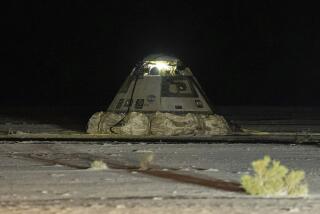The wrong stuff
A danger that NASA knew it had not resolved now haunts the seven-member crew orbiting aboard the space shuttle Discovery. We hope fervently that its current flight will end safely. When it does, no shuttle should ever fly again.
NASA’s chagrined announcement Wednesday stated that a large chunk of insulating foam had fallen off the shuttle’s external fuel tank but appeared not to have hit the orbiter. However, the astronauts were still assessing possible damage. In addition, it was known earlier that Discovery lost, on takeoff, an insulating tile near the front wheel well. That is being assessed as well.
The shuttles will be grounded until the agency “can do something about” the foam, the shuttle program manager said.
No, they should be grounded until the sun burns out.
The shuttle launched Tuesday to much fanfare and official jubilation despite doubts expressed last month by a safety panel. The panel was formed to oversee NASA’s upgrades in the wake of the deaths of the seven Columbia astronauts in 2003, when their craft disintegrated in flames while descending. The cause then: a piece of insulating foam that damaged wing tiles. In that tragedy, NASA knew the loose foam had struck the orbiter but never took up engineers’ suggestion to ask for a spy satellite to look at the extent of damage.
Last month, the NASA safety panel concluded that the agency had not eliminated the danger of pieces of ice and foam breaking off the external fuel tank. The practicality of possible spacewalk repair methods was not certain. The shuttle lifted off anyway, with concern focused not on the foam but on an iffy fuel sensor.
The aged shuttles (Discovery is 21 years old) are already at more than twice their intended design life. Engineers are sometimes reduced to hunting for obsolete hardware and electronics on EBay. Despite this, Congress has irrationally considered extending shuttle flights to 2014 or beyond.
Particularly galling is the shuttles’ chief remaining mission, servicing the International Space Station. The station, once intended as a platform for planetary exploration, is now only a floating laboratory for mostly trivial scientific experiments. It is expected to cost the U.S. and its partners $100 billion if it is ever completed (roughly 25 times the original budget of the shuttle program).
It is uncertain what will happen to the one American and one Russian left aboard the station. NASA did not, in Wednesday’s announcement, cancel Discovery’s visit there. The pair should return to Earth with Discovery, as long as it is determined to be safe. That should be the end of it, except for planning the space station’s ultimate, flaming descent in the safest possible way.
Scientific critics of NASA often accused it of being good only at fixing its last problem. Now the agency has failed even that.
More to Read
Sign up for Essential California
The most important California stories and recommendations in your inbox every morning.
You may occasionally receive promotional content from the Los Angeles Times.










